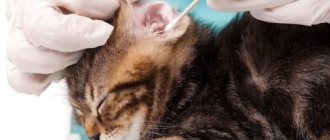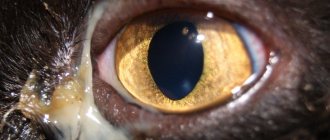Long lasting and non-healing sores on the neck of cats are dangerous to ignore, as this may be a symptom of a serious illness. Ulcers and wounds must be shown to a veterinarian; if you self-medicate, you can aggravate the disease and cause dangerous complications. After diagnostic tests, the doctor will prescribe treatment and tell you what to do next.
Causes of itching in the head and neck area in cats
Cats scratch their necks until they hurt for a variety of reasons. This behavior is provoked by external factors, ectoparasites and a number of diseases of varying degrees of danger. The largest number of cases are due to allergies and insect parasites. A smaller percentage of the probability is associated with viral, autoimmune and other diseases.
Ectoparasitosis
Otodectes cynotis, or ear scabies, is caused by mites. They settle in the ears or ear canal and cause severe itching in the cat. As a result, she regularly shakes her head and scratches her ears until they hurt. It is transmitted by contact and affects mainly young animals.
Notoedrosis or pruritic scabies develops against the background of Notoedres cati tick bites. The disease is characterized by inflammation of the scalp, hair loss and severe itching. An infected cat constantly scratches its head until sores appear.
Important! Notoedres cati itches spread from cats to other animals and even humans. For some time they cause pseudo-scabies and then go away, since there are no favorable conditions for life.
Cheyletiellosis, or wandering scabies, is caused by Cheyletiella mites. The fact that a cat has these parasites is indicated by severe itching and fine dandruff. The disease often spreads to humans and causes an itchy rash.
Demodectic mange or ironworm is the result of exposure to mites of the genus Demodex. They develop their vital activity in the sebaceous glands and hair follicles. As a result, bald patches of skin and sores appear on the cats’ faces. The areas most commonly affected are the areas around the eyes and mouth, as well as the front legs.
Fleas are a common cause of scratching on the neck and other parts of the body. They parasitize primarily on cats and dogs. They can also temporarily transfer to humans. When infected with them, a large number of black crumbs appear under the fur of pets. These flea droppings are especially noticeable in the lumbar and back areas.
The animals themselves itch very much to the point of soreness, as they experience severe itching at the bite sites.
Allergies
A common reason why a cat scratches itself until it hurts is allergies. It implies an abnormal reaction of the body to a stimulus. When first hit, protective cells create an antidote and “remember” the allergen. And if it penetrates again, a violent reaction occurs in the body. It leads to inflammation, itching and other symptoms.
Allergies cause several diseases in cats:
- atopic dermatitis;
- flea dermatitis;
- food allergies;
- contact dermatitis.
Flea dermatitis
Flea dermatitis is a common reason why a cat scratches itself until it hurts. When one flea bites, it releases a special anticoagulant into the cat's skin. This substance prevents blood clotting. The pet becomes sensitized to it. And the body reacts to the bites of other fleas in the form of inflammatory processes, rashes and papules.
The affected areas are very itchy. The cat begins to behave restlessly and reacts nervously to touch. This type of dermatitis occurs in two forms: chronic and latent. In the first case, alopecia (foci of baldness) and nodules with flea feces develop on the body. The second is characterized by the appearance of papules with a red rim.
The cat begins to tear them apart until they hurt. Often secondary infection is associated with wounds.
Atopic dermatitis
The disease is typical for young animals aged 1 to 3 years. The main reason for its appearance is the uncontrolled selection of cats. As a result, animals develop allergies to dust and pollen. In this case, it is almost impossible to identify the allergen.
Important! Atopic dermatitis has no cure; cats will regularly scratch their skin until it hurts. The action of therapy is aimed at suppressing symptoms.
Dermatitis in cats manifests itself with the following symptoms:
- the appearance of dandruff on the withers and back;
- hair loss;
- labored breathing;
- discharge from the eyes and nose;
- cough;
- profuse salivation.
Contact dermatitis
This allergy is similar in symptoms to atopic dermatitis. It often manifests itself when the pet comes into contact with household chemicals, toilet filler, the hair of other animals, and flea products. Contact allergies are manifested by severe itching, flaking of the skin and a small rash. Often a cat itches until it hurts. And this increases the risk of secondary infections.
Food allergies
Allergens can accumulate in the body of animals. With their regular consumption, health problems begin. Food allergies are characterized by:
- the appearance of a rash on the cat’s neck and head;
- hair loss;
- the appearance of dandruff;
- inflammation of the eyelids;
- unpleasant odor from the mouth.
Important! Symptoms of food allergies in cats are often accompanied by vomiting and indigestion.
A common cause of food allergies is feeding cats salted, fried, smoked and other prohibited foods from the table. Mixed feeding with industrial feed and natural products also contributes to its appearance.
Skin infections
Scratched cat sores on the neck and head in some cases occur due to infectious diseases. Cats with access to the outdoors are especially susceptible to them. When a bacterial infection of the skin occurs, one of two forms develops:
- Dry. Dry crusts, dandruff and scabs form on your cat's neck.
- Wet. It is characterized by the appearance of blisters and ulcers with liquid contents inside.
Animals with sensitive skin are predisposed to eczema. It develops through prolonged contact with flea collars, harnesses, after insect bites and skin parasites.
Important! Diabetes mellitus, neuropathy and hormonal changes contribute to the appearance of eczema.
A rash and blisters appear on the pet's body. Severe itching leads to the cat scratching its neck until it bleeds, and sores appear that do not go away for a long time. To eliminate eczema, antibacterial therapy, various ointments and powders are prescribed.
Viral dermatoses
Cat scratching on the skin is also characteristic of viral dermatoses. The herpes virus affects the eyes and respiratory tract of the animal, often manifesting itself as skin lesions. They are often localized in the area of the nose and eyes, less often on the paws and stomach.
Feline herpes is characterized by:
- bloody stains;
- small rash;
- swelling of the skin;
- small scabs on the neck, sores on the head.
Skin changes appear 1.5 weeks after the disappearance of conjunctivitis and other characteristic symptoms.
Cowpox or poxvirus is a rare disease. It can enter the cat's body through the bites of small rodents. It manifests itself as skin lesions in the form of nodules and small ulcers. With good immunity, it goes away on its own. In weakened animals there is a risk of developing a severe form.
Autoimmune dermatoses
Autoimmune diseases are characterized by an abnormal reaction of the immune system to its own tissues and cells. Skin manifestations on the body of cats are characteristic of several diseases:
- Common pemphigus. It is characterized by the development of ulcers in cats around the mouth and in its cavity itself. Involves long and difficult treatment. It often ends critically for animals.
- Erythematous pemphigus. Crusts, ulcers, blisters, sores and other lesions are concentrated in the area of the animal’s nose and bridge of the nose. Sometimes the disease is accompanied by a change in skin color.
- Pemphigus foliaceus. The main symptom is the appearance of large pustules on the skin near the mouth and ears. Associated signs in cats include elevated body temperature, refusal to eat, and apathy.
- Systemic lupus erythematosus. It affects all systems and organs of the animal. Wounds on the scalp manifest themselves through depigmentation of the skin, the development of a rash and the subsequent formation of ulcers.
Diagnostic and therapeutic measures
The next possibility is the presence of an infectious or parasitic disease: skin mites (for example, demodex) or fungal diseases. In this case, the clinic offers the following tests:
- A general blood test to check for the presence of an inflammatory process.
- Scraping from the surface of the wound to determine the type of mite.
- Smears are impressions from the surface of the wound. They are studied under a microscope to determine the type of pathogen: fungi, bacteria, etc.
- Plucking and examining animal hair under a microscope.
- Luminescent diagnostics – detects some types of fungal diseases.
- Tissue culture is used for more severe symptoms.
Medical treatment of all types of skin diseases, including if a cat’s neck wound does not heal, requires an integrated approach. Antihistamines are prescribed (to reduce itching), antibiotics to remove secondary microflora for 10-21 days, local preparations in the form of ointment, lotion, cream and medicated shampoos (based on chlorhexidine or antifungal components) for bathing 1-2 times a day. week. A 1.5-2 month diet will be a must.
Under no circumstances should “human” medications be used in pediatric dosages. When treating pets, the dose of the drug is specific and is calculated by a veterinarian based on the weight of the pet and the type of animal. A different dosage may worsen the situation.
The last and more typical occurrence of a wound on a cat’s neck is the pet’s pugnacity. In the heat of mating season or during the development of territories adjacent to the house, cat fights are very common. Naturally, after battles, the cat trudges back hungry, exhausted and wounded. If blood oozes out of the wound, you should immediately contact a veterinarian.
The risk of losing a pet from bleeding is very high.
In case of only skin injuries without blood loss, you can help yourself. Proceed as follows:
- disinfect the wound with 3% hydrogen peroxide;
- treated with Chlorhexidine solution for 5-7 days;
- Levomekol ointment is applied to the wound;
- the wound should be bandaged or a veterinary collar should be purchased, since cats often lick their wounds, and there is nothing useful in their saliva. This will only interfere with healing.
Wound treatments are carried out twice a day: morning and evening. If the wound is extensive, you should contact a veterinary clinic for antibiotics and suturing of the wound.
In conclusion, we note that if it is impossible to help your pet on your own, you should not waste time and money in contacting a specialist. Only a doctor can prescribe tests and make the correct diagnosis. Don’t forget: “We are responsible for those we have tamed.”
Skin tumors
Skin neoplasms are in first place among oncological diseases in animals. By their nature, they are also divided into benign and malignant forms.
The first includes:
- Basalioma. The sore is a pigmented dome-shaped tumor. At the point where it appears, the animal loses its hair.
- Cutaneous histiocytoma. Characterized by a rapidly growing tumor under the skin. A rare pathology for cats.
Malignant skin tumors develop in two cases:
- Squamous cell carcinoma. The disease manifests itself in the nose, eyelids and ears. Metastases spread through the lymphatic system.
- Basal cell carcinoma. Develops from basal cells of the skin. Characterized by rapid growth and a high probability of metastasis.
History taking
Diagnostics will help you understand why your cat scratches its neck and what caused the sores. But before carrying it out, the veterinarian needs to collect an anamnesis.
Age and breed
A kitten up to one year old is susceptible to skin and subcutaneous parasites. Young animals suffer predominantly from allergic reactions. If an elderly cat scratches its neck until it bleeds and hurts, this may be due to autoimmune dermatoses.
The breed of the animal also leaves its mark. Persian cats are prone to dermatophytosis and dermatitis, while Sphynx cats are prone to allergies and neoplasms.
Lifestyle
A large number of animals in one area, access to the street, participation in cat shows and other factors increase the risk of infection with parasites and viral diseases.
Seasonality
Allergies to pollen, bee or mosquito bites have a pronounced seasonality. Flea dermatitis in cats manifests itself regardless of the time of year. But it is most common in August-September.
Can you help your pet yourself?
Mostly, redness and sores on a cat's neck are accompanied by peeling and crusting. For a few wounds, it is recommended to purchase medical sulfur from a pet store and add it to your pet’s food (on the tip of a knife) for 14 days. Fertilizing with sulfur is also carried out for preventive purposes in the spring and autumn.
If the transition to proper nutrition has been made, 10-14 days have passed, and there is no improvement, it is time to consult a veterinarian, because the allergy may be atopic in nature. Then the allergic reaction may be provoked by house dust mites, spring flowering or other environmental factors.
Diagnostic methods
Diagnostics will help determine why a cat scratches its neck until it hurts. The doctor prescribes one or more methods:
- Combing wool. A fine comb is used for this. The procedure allows you to see fleas, lice and skin mites on cats. Can be done independently at home.
- Trichogramma. Determines the presence of spores and eggs on the hair shaft.
- Examination of earwax under a microscope. It is carried out if otodectosis is suspected.
- Wood's lamp. Shows the glow of spores on the skin of an animal from certain types of fungus.
- Cytological examination. The veterinarian recommends this to detect yeast and bacterial infections.
- Allergy test. Prescribed for confirmed atopic allergies in cats.
- Skin scraping. Detects ticks, their larvae, and spores.
- Elimination diet. Prescribed by a veterinarian to determine the allergen for food allergies.
- Fungal culture. An effective method for dermatophytes.
What treatment is prescribed?
The presence of such defects on your pet’s skin requires a mandatory visit to the veterinarian.
Before starting therapy, it is necessary to find out why the cat’s skin is covered with sores. Therefore, you cannot do without a visit to the veterinarian, since according to the dermatologist of the Bely Klyk clinic, Ekaterina Kuznetsova, it will not be possible to determine the diagnosis only by the appearance of the lesion. After the initial examination, the doctor will give directions for the following diagnostic measures:
- general and biochemical blood test;
- smears and scrapings;
- examination using ultraviolet light.
Effective drugs
Once the diagnosis is known, the veterinarian will prescribe a comprehensive drug therapy regimen. Depending on the nature of the pathology that caused the rash, the following groups of drugs are used:
- antihistamines;
- steroid hormones;
- painkillers;
- antibiotics;
- antifungal agents;
- antiparasitic;
- antiprotozoal;
- disinfectant solutions.
The resulting wounds will go away faster if they are treated with Levomekol.
In order for wounds to heal faster, it is necessary to smear them with wound-healing and antimicrobial ointments. The drug "Levomekol" is suitable, which should be applied to the ulcer itself and the skin around it. To maintain immunity, additional vitamins and a therapeutic diet are prescribed. If an abscess has formed on the skin, conservative methods will not help. Then surgical removal of the tumor is performed.











